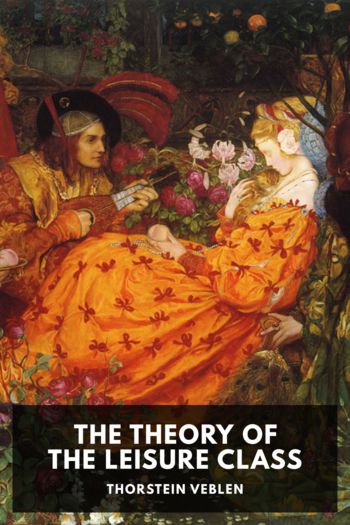The Theory of the Leisure Class - Thorstein Veblen (english books to improve english txt) 📗

- Author: Thorstein Veblen
Book online «The Theory of the Leisure Class - Thorstein Veblen (english books to improve english txt) 📗». Author Thorstein Veblen
Something similar should hold true with respect to diverse items of conspicuous consumption, and indeed something of the kind does seem to hold to a slight degree of sundry features of dress, especially if such features involve a marked discomfort or appearance of discomfort to the wearer. During the past one hundred years there is a tendency perceptible, in the development of men’s dress especially, to discontinue methods of expenditure and the use of symbols of leisure which must have been irksome, which may have served a good purpose in their time, but the continuation of which among the upper classes today would be a work of supererogation; as, for instance, the use of powdered wigs and of gold lace, and the practice of constantly shaving the face. There has of late years been some slight recrudescence of the shaven face in polite society, but this is probably a transient and unadvised mimicry of the fashion imposed upon body servants, and it may fairly be expected to go the way of the powdered wig of our grandfathers.
These indices and others which resemble them in point of the boldness with which they point out to all observers the habitual uselessness of those persons who employ them, have been replaced by other, more dedicate methods of expressing the same fact; methods which are no less evident to the trained eyes of that smaller, select circle whose good opinion is chiefly sought. The earlier and cruder method of advertisement held its ground so long as the public to which the exhibitor had to appeal comprised large portions of the community who were not trained to detect delicate variations in the evidences of wealth and leisure. The method of advertisement undergoes a refinement when a sufficiently large wealthy class has developed, who have the leisure for acquiring skill in interpreting the subtler signs of expenditure. “Loud” dress becomes offensive to people of taste, as evincing an undue desire to reach and impress the untrained sensibilities of the vulgar. To the individual of high breeding, it is only the more honorific esteem accorded by the cultivated sense of the members of his own high class that is of material consequence. Since the wealthy leisure class has grown so large, or the contact of the leisure-class individual with members of his own class has grown so wide, as to constitute a human environment sufficient for the honorific purpose, there arises a tendency to exclude the baser elements of the population from the scheme even as spectators whose applause or mortification should be sought. The result of all this is a refinement of methods, a resort to subtler contrivances, and a spiritualization of the scheme of symbolism in dress. And as this upper leisure class sets the pace in all matters of decency, the result for the rest of society also is a gradual amelioration of the scheme of dress. As the community advances in wealth and culture, the ability to pay is put in evidence by means which require a progressively nicer discrimination in the beholder. This nicer discrimination between advertising media is in fact a very large element of the higher pecuniary culture.
VIII Industrial Exemption and ConservatismThe life of man in society, just like the life of other species, is a struggle for existence, and therefore it is a process of selective adaptation. The evolution of social structure has been a process of natural selection of institutions. The progress which has





Comments (0)